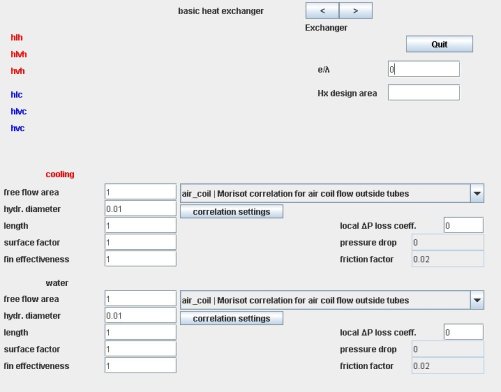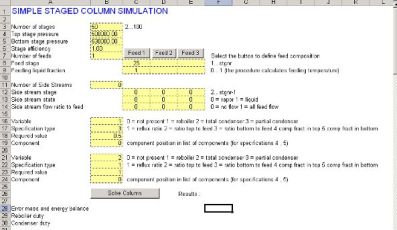- Condenser design (CnD) is a software tool that is made to demonstrate the thermal design calculations of Shell & Tube condensers. The software can design, horizontal condensers, vertical condensers including reflux condensers.
- The condenser load will be determined by the value of the enthalpy. mass flow of all streams entering minus the enthalpy. mass flow of the subcooled condensate leaving. The LP turbine L-0 blade useed energy end point UEEP may be 10% liquid by weight in a modern steam turbine, and thus this enthalpy is less than sat steram.
Thermal design calculations of Shell & Tube condensers for horizontal condensers, vertical condensers including reflux condensers; main features: +Support S.I Units/English (U.S) Units of measurement, Units converter containing 23 measurements and 200 units. +Import physical properties data to hot side and cold side from Microsoft Excel & from WeBBusterZ Physical properties database (included.
2.2.2 Condenser mode

In many vacuum processes (drying, distillation), large volumes of vapor are released that have to be pumped down. Moreover, significant volumes of leakage air will penetrate into large vessels, and those substances that are being vaporized or dried will release additional air that is contained in pores or dissolved in liquids.
In drying processes, the vapor can always be displaced against atmospheric pressure by a vacuum pump having sufficient water vapor capacity and can then be condensed there. However, this process has the following disadvantages:
- The pump must be very large
- A large volume of gas ballast air will be entrained which, together with the vapor, will carry a great deal of oil mist out of the pump
- It will be necessary to dispose of the resulting condensate from the water vapor and oil mist, which is a costly process
Distillation processes operate with condensers, and the object is to lose as little of the condensing distillate as possible through the connected vacuum pump.
Let us consider a vacuum chamber, or recipient, containing material to be dried, to which enough energy will supplied by heat that 10 kg of water will evaporate per hour.
In addition, 0.5 kg of air will be released per hour. The pressure in the chamber should be less than 10 hPa. A pumping station in accordance with Figure 2.3 is used for drying, enabling the steam to be condensed cost-effectively through the use of a condenser.
The material to be dried (2) is heated in the vacuum chamber (1). The Roots pump (3) pumps the vapor / air mixture into the condenser (4), where a major portion of the vapor condenses.
The condenser is cooled with water. The condensing water at a temperature of 25°C is in equilibrium with the water vapor pressure of 30 hPa. An additional vacuum pump (5) pumps the air content, along with a small volume of water vapor, and expels the mixture against atmospheric pressure. The first step is to calculate the gas flow from the chamber: $Q=p_{vc} cdot S_1$
With the ideal gas law according to Formula 1-15 we obtain
[Q=p_{vc} cdot S_1 = frac{R cdot T}{t} cdot left( frac{m_{water}}{M_{water}} + frac{m_{air}}{M_{air}} right)]
Formula 2-11: Gas throughput for pumping down vapors
| $T$ | Intake gas temperature | [K] |
| $R$ | General gas constant | [kJ kmol-1 K-1 |
| $t$ | time | [s] |
| $p_{vc}$ | Pressure in vacuum chamber | [Pa] |
| $m_{water}$ | Water vapor mass | [kg] |
| $M_{water}$ | Molar mass of water | [kg mol-1] |
| $m_{air}$ | Air mass | [kg] |
| $M_{air}$ | Molar mass of air | [kg mol-1] |

Where:
| $T$ | Intake gas temperature | 300 K |
| $R$ | General gas constant | 8.314 kJ kmol-1 K-1 |
| $t$ | time | 3600 s |
| $p_{vc}$ | Pressure in vacuum chamber | 1000 Pa |
| $m_{water}$ | Water vapor mass | 10 kg |
| $M_{water}$ | Molar mass of water | 0.018 kg mol-1 |
| $m_{air}$ | Air mass | 0.5 kg |
| $M_{air}$ | Molar mass of air | 0.0288 kg mol-1 |
we obtain a gas throughput for air of 12 Pa m3 s-1 and for water vapor of 385 Pa m3s-1, together 397 Pa m3s-1. Divided by the inlet pressure $p_{vc}$ von 1000 Pa we obtain a pumping speed $S_1$ von 0.397 m3s-1 or 1429 m3h-1.
When evacuating the condenser, the partial air pressure should not exceed 30 %, i. e. a maximum of 12.85 hPa. It follows from this that:
$S_2=frac{Q_{air}}{0.3 cdot p_{air}}$
Condenser Design Calculation Excel Formula
With a gas throughput for air of 12 Pa m3 s-1 and a pressure of 1285 Pa, a pumping speed $S_2$ of 0.031 m3 s-1 or 112 m3 h-1 is obtained.
We therefore select a Hepta 100 screw pump as the backing pump. Because its pumping speed is somewhat lower than the calculated one, this pump will achieve a slightly higher partial air pressure. And we select an Okta 2000 with the following values as the Roots pump:
| $S_0$ | 2065 m³ h-1 |
| $Delta p_d$ | 35 hPa differential pressure at the overflow valve |
| $K_0$ | 28 where $p_v$= 43 hPa |
We estimate the inlet pressure $p_a$ = 1000 Pa and calculate $S_1$ in accordance with Formula 2-7.
$S=S_0 cdot left[ 1- frac{1}{K_0} left( frac{p_v}{p_a} -1 right) right]$
We obtain a pumping speed $S_1$ of 0.506 m3 s-1 or 1.822 m3 h-1.
With $p_a=frac{Q}{S_1}
and a value for $p_a$ vof 785 Pa we obtain the inlet pressure in the drying chamber, and by using this figure again in Formula 2-7 we arrive at the more precise pumping speed $S_1$ = 1.736 m³ h-1 for an inlet pressure $p_a$ = 823 Pa.
We calculate the condenser for a 10 kg h-1 volume of vapor to be condensed. The following applies for the condensation surface area:
[A_k= frac{Q_{water} cdot m_{water}}{t cdot Delta T_m cdot k} ]
Formula 2-12: Calculation of the condensation surface area
| $A_k$ | Condensation surface area | [m2] |
| $Q_{water}$ | Specific enthalpy of evaporation | [Ws kg-1] |
| $m_{water}$ | Water vapor mass | [kg] |
| $Delta T_m$ | Temperature differential between vapor and condensation surface | [K] |
| $k$ | Thermal transmission coefficient | [W m-2 K-1] |
Where:
| $Q_{water}$ | 2.257 ⋅ 106 Ws kg-1 |
| $m_{water}$ | 10 kg |
| $t$ | 3600 s |
| $Delta T_m$ | 60 K |
| $k$ | 400 W m-2 K-1 |
we obtain a condensation surface area of $A_k$ 0.261 m2.
The vapor is heated by more than 100 K through the virtually adiabatic compression, however it re-cools on the way to the condenser. So the assumption that $Delta T_m$ = 60 K is quite conservative. The thermal transmission coefficient $k$ [20] decreases significantly as the concentration of inert gas increases, which results in a larger condensation surface area. Inversely, with a lower concentration of inert gas, it is possible to work with a larger backing pump and a smaller condensation surface area. Particular attention should be paid to small leakage rates, as they, too, increase the concentration of inert gas.

Further technical details can be obtained from the special literature [21].
Figure 2.4: Roots pumping station for vapor condensation
In the interest of completeness, let us again consider the entire sequence of the drying process: a pressure equilibrium initially occurs in the drying chamber, which results from the water volume that is being vaporized and that is caused by the heating-up of the material to be dried and the volume flow rate of the Roots pump.
Condenser Design Excel
The Roots pump advances the water vapor into the condenser, where it condenses. Because laminar flow prevails there, the vapor flow advances the inert gas released by the material to be dried into the condenser.
Were the backing pump to be shut down, the entire condensation process would quickly come to a stop, as the vapor could only reach the condensation surface area through diffusion. As the drying process progresses, the volume of vapor decreases and less condenses in the condenser; however the concentration of vapor extracted by the backing pump will tend to be larger if the concentration of inert gas decreases. If the vapor pressure in the condenser drops below the condensation threshold, the condensate will begin to re-evaporate. This can be prevented if the condensate drains into a condensate storage vessel via a valve and this valve closes when the vapor pressure falls below the condensation pressure.
In the case of large distillation systems, the pumping speed of the backing pump should be regulated on the basis of the condensation rate. This can be accomplished, for example, with the aid of a dosing pump that uniformly discharges the volume of pumped condensate from the storage vessel. When the concentrate level in the storage vessel falls below a given level, the backing pump’s inlet valve opens and the inert gas that has collected in the condenser is pumped down. The condensation rate now increases again, the condensate level increases and the backing pump’s inlet valve closes again. This arrangement means that the system pumps only when the condensation rate is too low, and only little condensate is lost.

Summary
When pumping down vapors (drying, distillation), the major pumping effect can be provided by a condenser. Depending upon pressure and temperature conditions, either one or two condensers can be used (Figure 2.4). The condenser between the Roots pump and backing pump is more effective, as the vapor flows into the condenser at a higher temperature and higher pressure, and a small backing pump evacuates only a portion of the vapor. In distillation, condensate loss can be minimized by regulating the pumping speed of the backing pump.
The above-mentioned theoretical principles are frequently used to configure Roots pumping stations. Figure 2.5 shows a vacuum solution for reducing the residual moisture of the paper material used in the production of submarine cables. A pre-condenser (not shown) condenses the water vapor mainly during the first drying phase at high process pressures. An intermediate condenser protects the downstream BA 501 rotary vane pump and condenses the water vapor mainly during a second drying phase.
Figure 2.6 shows a Roots pumping station used for transformer drying The intermediate condenser reduces the residual moisture of the material used to the extent that the water vapor capacity of the downstream BA 501 rotary vane pump is not exceeded.
Figure 2.5: Roots pumping station for vapor condensation
Condenser Heat Transfer Calculations
Figure 2.6: Roots pumping station for transformer drying